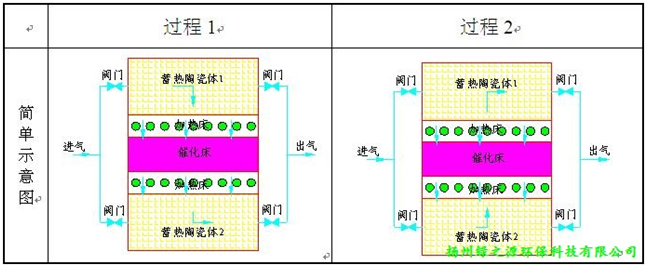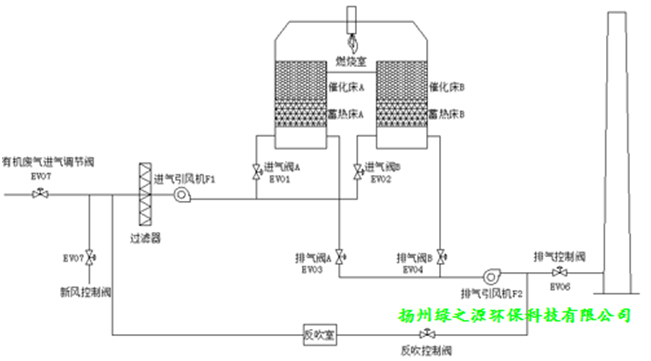
LINK:


Lvzhiyuan

 Lvzhiyuan
Lvzhiyuan


THREE:Process principle
In the industrial production process, the discharged organic tail gas enters the rotary valve of the equipment through the induced draft fan, and then the rotary valve completely separates the inlet gas and the outlet gas. The gas first passes through the ceramic material filling layer (bottom layer) and is preheated to generate heat storage and heat exchange, and its temperature almost reaches the temperature set by the catalytic layer (middle layer) for catalytic oxidation. At this time, some of the pollutants are oxidized and decomposed; the exhaust gas continues Through the heating zone (the upper layer, which can be heated by electric heating or natural gas), the temperature is increased and maintained at the set temperature; it then enters the catalytic layer to complete the catalytic oxidation reaction, that is, the reaction generates CO2 and H2O, and releases a large amount of heat to achieve Expected processing effect. The gas after catalytic oxidation enters other ceramic filling layers, and after recovering heat energy, it is discharged into the atmosphere through a rotary valve. The temperature of the exhaust gas after purification is only slightly higher than the temperature before the exhaust gas treatment. The system runs continuously and switches automatically. Through the operation of the rotary valve, all the ceramic filling layers complete the cycle steps of heating, cooling and purification, and the heat can be recovered.
The RCO regenerative catalytic combustion device uses rotary valves to replace many valves and complex hydraulic equipment in traditional equipment. The removal rate of organic matter can reach more than 98%, and the heat recovery rate can reach 95-97%.

◆Regenerative catalytic oxidation technology is a new technology developed on the basis of high temperature incineration (TO) technology and catalytic oxidation (CO). It mainly adopts advanced heat exchange design technology and selection of new animal heat materials. The exchange efficiency of traditional heat exchange design technology is generally 50-70%. Improving heat exchange efficiency means geometrically increasing the manufacturing cost of equipment and greatly increasing the volume of heat exchange equipment; regenerative heat exchange adopts modern advanced technology. The design concept enables the equipment volume and manufacturing cost to be effectively controlled while increasing the heat exchange efficiency to 95% or even higher.
FOUR:Scope of application
◆Types of organic gases that can be handled: benzene, ketones, esters, phenols, aldehydes, alcohols, ethers, hydrocarbons, tea, benzo (a) castor and malodorous gases, etc.;
◆Coating production lines of automobiles, shipbuilding, motorcycles, bicycles, household appliances, containers, etc.
◆Production lines for petroleum, chemical, rubber, paint, paint, shoe-making viscose, plastic products, printing iron cans, printing ink, cables and enameled wires;
◆It is especially suitable for waste gas treatment of enterprises or drying lines that need heat energy recovery. Energy recovery can be used for drying lines, so as to achieve the purpose of saving energy.
Five:performance characteristics
◆Catalytic combustion is in the environment of 200-500 ℃, the exhaust gas is converted into CO2, H2O and other products by catalytic oxidation on the surface of the catalyst, the purification efficiency is as high as 95-99.5%, and there is no secondary pollution (HOX).
◆Due to the adoption of advanced energy-saving technology, the energy consumption of the equipment is ≤8W•Hr/NM3, which is 60-90% lower than that of existing various types of catalytic equipment. Compared with direct combustion equipment, it does not need liquid or gas fuel, which is convenient for enterprises to Various locations to choose from.
◆The allowable organic waste gas concentration range of regenerative catalytic combustion equipment is 200-8000mg/NM3, and its uniquely designed high-efficiency and advanced heat exchange system ensures the effective recovery of combustion heat, so it also has outstanding performance in the field of high-flow and low-concentration organic waste gas purification. The advantages.
SIX. Performance parameter table
Specifications | RCO | RCO | RCO | RCO | RCO | RCO | RCO | RCO |
Handling air volume ㎥/h | 1000 | 2000 | 3000 | 5000 | 8000 | 10000 | 15000 | 20000 |
Process gas type | Benzenes, ketones, alcohols, aldehydes, esters, ethers, alkanes and other organic mixed gases | |||||||
Organic gas concentration | 200~8000mg/㎥(Mixed gas lower explosion limit 1/4) | |||||||
Gas preheat temperature | 220~320℃ | |||||||
Decomposition temperature | 350~600℃ | |||||||
Purification efficiency | ≥97% | |||||||
Heating power kw | 21 | 30 | 36 | 48 | 81 | 90 | 130 | 160 |
Fan power kw | 5 | 7.5 | 11 | 15 | 22 | 22 | 30 | 55 |
Note: Special specification requirements, separately designed